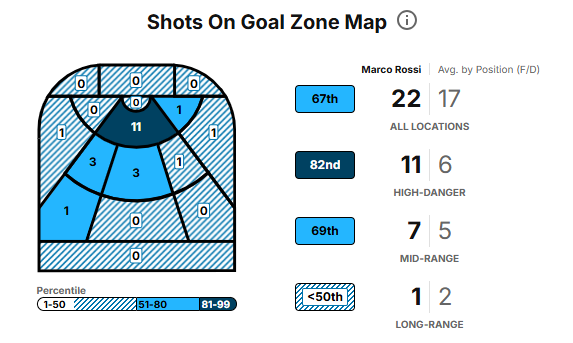With the Minnesota Wild in seventh place in their division after going 2-5-3 in their last ten games, there’s a lot to criticize about the way they have started the season. Brock Faber is having issues, Father Time might finally be catching up to Jared Spurgeon, and so on.
In all the doom and gloom, it’s easy to overlook the few things that have gone right for Minnesota. One such aspect is Marco Rossi’s play.
It’s fascinating how infrequently people bring up Rossi’s name, given that in years past, it seems like the Austrian winger was always a focal point.
The Wild, somewhat inexplicably, have seemed hell-bent on exploring trade options for their former first-round pick despite his consistent improvement and contributions. Things finally came to a head this offseason when Minnesota re-signed Rossi to a three-year bridge deal that secured his future in St. Paul (at least for now).
Given that he was one of the biggest stories for the Wild all summer, it’s only fair to give him credit for living up to his new deal. He’s been one of the lone bright spots for the Wild in the early season.
Rossi is off to a hot start. If there’s a central theme to showcase how he’s improved his game, it’s that the young center is answering questions about his development.
In the past, Rossi has been good, but it’s fair to ask if he could truly cement himself as a top-six center. This question was especially pertinent after the Wild played Rossi in their top six for most of last season before demoting him to the fourth line for the playoffs.
If Rossi’s early results indicate how he’ll play all season, he isn’t just keeping up with the Wild’s best players but is building real chemistry on the top two lines. Of the Wild’s top five performing line combinations this season, based on expected goals percentage, Rossi is the center of three of them.
His wingers have been different combinations of Minnesota’s top players:

(Source: Moneypuck)
The Wild’s top lines have performed well with Rossi centering them, but have they resulted in positive on-ice results? At least for Rossi, the answer is a resounding yes.
Rossi has 12 points in 12 games, which would be the best pace of his career if he continues to be a point-per-game player. Rossi had his most productive year last season, scoring roughly .73 points per game. However, Rossi’s passing has created the most significant boost in point production.
The Austrian center had 36 assists in 82 games last season, or roughly .44 assists per game. In Rossi’s 12 games this season, Rossi has nine assists in 12 games (.75 per game). Rossi’s jump in playmaking is a welcome addition to his toolbox, given that there were times last season when he’d disappear from the scoresheet for a while if he weren’t scoring goals.
Rossi’s assists aren’t just the product of being in the right place at the right time, either. His four primary assists are the fourth most on the team, and he’s making real plays.
Vladimir Tarasenko scored his first of the season on the play, but Rossi did a substantial amount of the work. Rossi uses his trademark ability to slip in front of the net undetected to set himself up for a key takeaway after a rebound. He makes a clever play by opening up away from the boards and finds a streaking Tarasenko before the Philadelphia Flyers’ defense can close in on him.
The passing play to set up Tarasenko showcases another aspect of Rossi’s game that’s going well: His expertise in creating chances from in front of the net. While it may surprise some due to his well-publicized small stature, Rossi has always been great at creating havoc from the most dangerous areas of the ice.
That’s continued this season, as his 11 high-danger shots on goal place him in the 82nd percentile among NHL players, according to NHL EDGE statistics.

(Source: NHL EDGE)
Rossi’s penchant for creating high-scoring chances is part of a larger trend of the forward’s ability to develop a positive quality of possession when he’s on the ice. The center currently leads the Wild in 5-on-5 Corsi-for percentage with 58.41%. That mark is the highest of his career.
One of the main reasons Rossi has been so elite at driving possession is that he (and his line) are adept at getting and keeping the puck in the offensive zone. According to NHL EDGE, Rossi starts 38% of his shifts from faceoffs in the offensive zone, but he spends even more time attacking at even strength.

(Source: NHL EDGE)
Rossi’s elite play-driving also makes him one of the Wild’s most effective defenders. Not in the sense that he makes great plays in his own end, but in that other teams can’t score when they don’t have the puck. Rossi’s 2.37 expected goals against per 60 minutes is the lowest mark of any Minnesota player who’s played more than 100 minutes this season.
Of course, he hasn’t been perfect. Rossi still isn’t the strongest faceoff man, but even with that being said, his faceoff numbers are up. His current 48.8% win rate is the best of his career.
Rossi also isn’t putting the puck in the net quite as much as he did last year (.25 goals per game compared to .30 goals per game). Still, as shown by his shot chart, he’s getting to dangerous areas of the ice. The goals will come.
It’s easy to look back on the year Minnesota has had and feel mainly negative feelings. The team isn’t playing well, and there are so many questions that don’t appear to have easy answers.
Rossi’s growth won’t fix all of Minnesota’s problems, but it’s proof that not everything in St. Paul is trending the wrong way. In a season defined by uncertainty, Rossi’s steady rise might be the most encouraging sign the Wild have.
